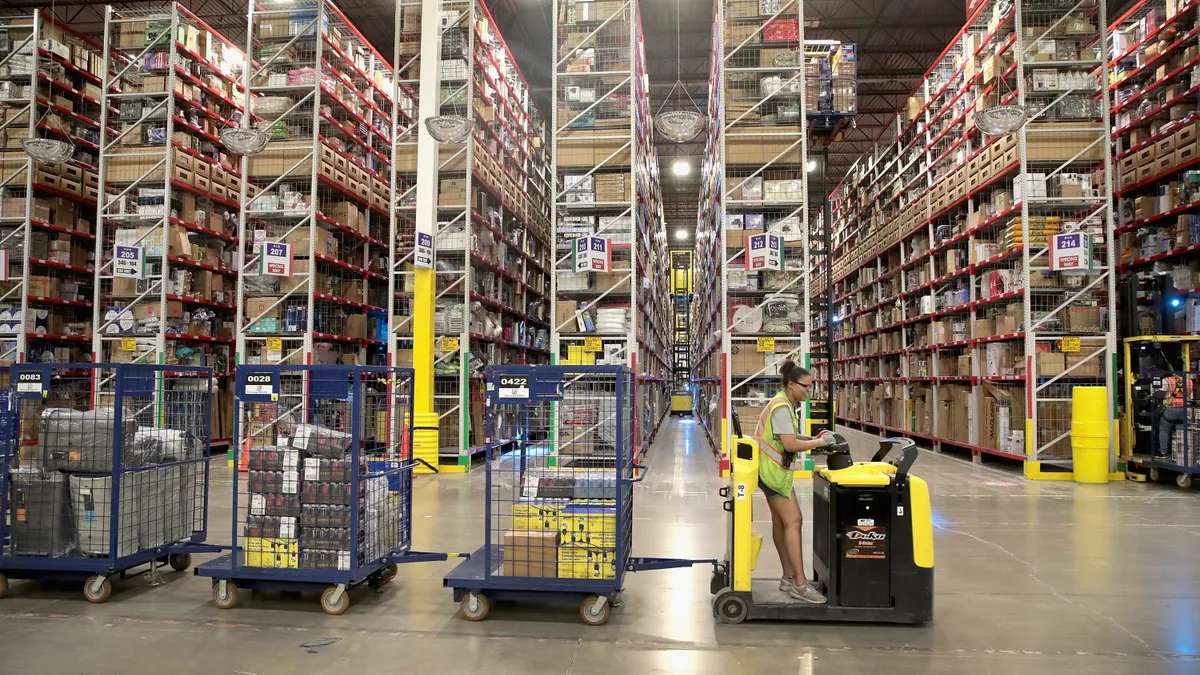Amazon sellers are assessing alternate shipping and storage plans to counter capacity constraints within the e-commerce giant's logistics network ahead of the holidays.
The capacity issues, coming in the thick of Amazon's inbound fulfillment makeover, are leading to extended processing times for seller inventory at some West Coast facilities. Amazon has rerouted goods to other regions and lowered fees for products going to Eastern U.S. locations in an attempt to right the ship.
“We are actively working to mitigate these delays and expect to be back to normal processing times in the next few weeks,” an Amazon spokesperson said in a statement to Supply Chain Dive.
But experts say current constraints are unlikely to be resolved until 2025, forcing sellers to make difficult decisions before the holiday season: avoid bottlenecks with more expensive restocking methods, or risk low inventories when demand spikes.
"I just think that we're just trying to get through the rest of the year, is the easiest way to say it," said Joe Stefani, president and founder of Desert Cactus, which sells licensed products on Amazon.
Asia imports strain Amazon warehouses
Desert Cactus began seeing inbound fulfillment issues around the end of July, with much of its inventory tied up in Amazon Warehousing & Distribution (AWD), the e-commerce giant's bulk storage service, Stefani said.
AWD aims to help sellers more easily replenish inventory for Fulfillment by Amazon (FBA) shipping to end customers while avoiding inbound placement fees. Amazon has already quadrupled the amount of storage space available for AWD users this year, the company spokesperson said, but high demand has resulted in "backlogs of a few days longer than normal in some of our locations."
Sellers and experts told Supply Chain Dive that current capacity challenges are particularly pronounced at facilities used for AWD storage along the West Coast.
Many Amazon sellers rely on sourcing from Asia, and the West Coast is a natural location for them to store imports for eventual distribution. But inventory is flowing to a select few sites in the region as these sellers embrace Amazon's "minimal shipment splits" plan, which has sellers send inventory to a single location and pay Amazon a fee for further distribution. As a result, sellers are grappling with strained capacity, Rob Hahn, COO of e-commerce services provider Pattern and a former Amazon executive, said on LinkedIn.
"They can't let this keep going, because you're just going to have more and more sellers leave the platform."

Joe Stefani
President and founder of Desert Cactus, an Amazon seller
The flood of inventory has sparked instances of lengthy delays to get products processed in AWD and ready to ship to customers through FBA, experts told Supply Chain Dive. It has also created what Stefani described as "very sporadic" inbound inventory flows within the e-commerce giant's network. Earlier this year, some Desert Cactus products had just 50 pieces in stock via FBA, despite thousands of units available at AWD locations.
"They got to figure out what the root cause is and fix it," Stefani said of Amazon. "They can't let this keep going, because you're just going to have more and more sellers leave the platform."
Sellers pay to stay in stock
For sellers navigating the inbound fulfillment issues, experts told Supply Chain Dive that being overstocked and incurring higher storage fees outweighs the downside of potential inventory shortages during the holidays.
"The worst thing is to go out of stock," said Jon Elder, founder and CEO of Amazon seller consultancy Black Label Advisor. "You get dinged on your rankings, and you basically get punished for that. So sellers are spending more to get stuff checked in faster."
Elder said some sellers are opting for air freight to get critical inventory into Amazon's network faster. He also has clients with backup inventory at 3PL warehouses, rather than fully relying on Amazon's network for storage.
"It's obviously not cheap, but that's basically inventory that sits just in case you need to use it," Elder said. "So they're going to deploy that because all the stuff got stuck on the West Coast, and they have resources to do that."
Smaller businesses without the budget to leverage outside storage may want to team up with other Amazon sellers to mitigate capacity constraints, said Abe Orgel, CEO at freight forwarder Simple Forwarding. He recommended shipping inventory together as full truckloads to multiple locations, rather than taking on the cost of a less-than-truckload shipment individually.
"The worst thing is to go out of stock."

Jon Elder
Founder and CEO, Black Label Advisor
For Desert Cactus, the company is sending some shipments to FBA that would otherwise go through AWD, despite higher storage rates. Stefani said he's fine absorbing the added costs if it means having inventory readily available for Amazon shoppers.
"I'm fine with spending $10,000 a month in storage," Stefani said. "It is what it is. At least it's checked in and it's there."















